Parallel connection. Sequential and parallel connection of conductors
Reiteration
Chizhova Vera Alexandrovna
Teacher of Physics and Informatics
MBOU SOSH, Red,
Nenets Autonomous Okrug.
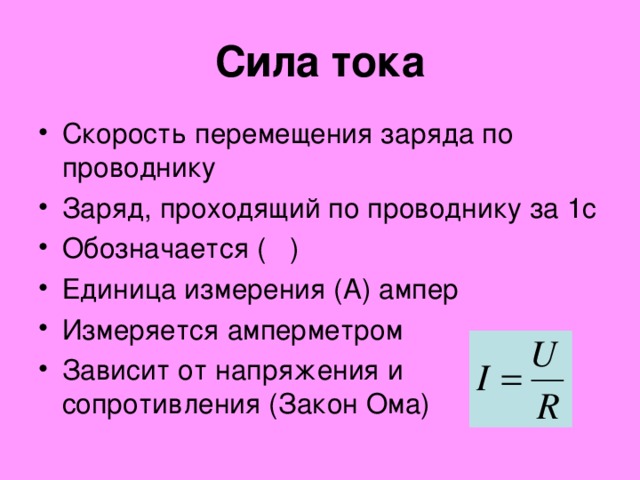
- Speed of charge transfer by conductor
- The charge passing through the conductor in 1 s
- Denoted by ()
- Unit of measurement (A) ampere
- Measured by an ammeter
- Depends on voltage and resistance (Ohm's law)
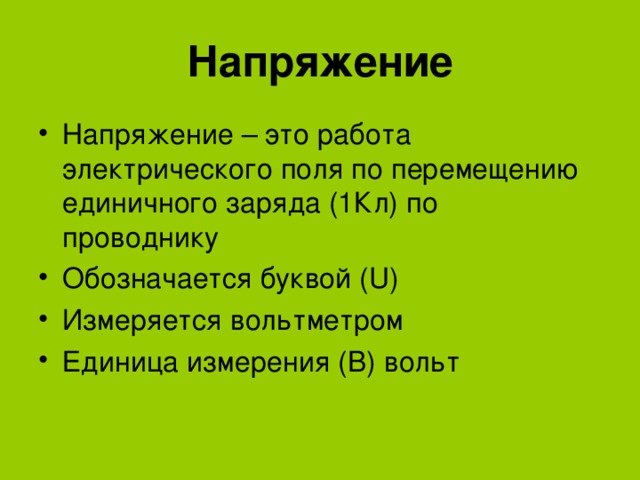
- Voltage - is the work of an electric field on the movement of a single charge (1C) through a conductor
- Denoted by the letter (U)
- Measured with a voltmeter
- Unit of measurement (V) volts

- The property of a conductor to obstruct the motion of charged particles along a conductor under the action of an electric field
- Denoted by R
- Unit of measure (Ohm)
- Depends on the physical properties of the conductor

Laws of a series connection of conductors
- The current is the same in all parts of the circuit
- The total resistance of the circuit is equal to the sum of the resistances of the individual sections of the circuit
- The total voltage is equal to the sum of the stresses in individual sections
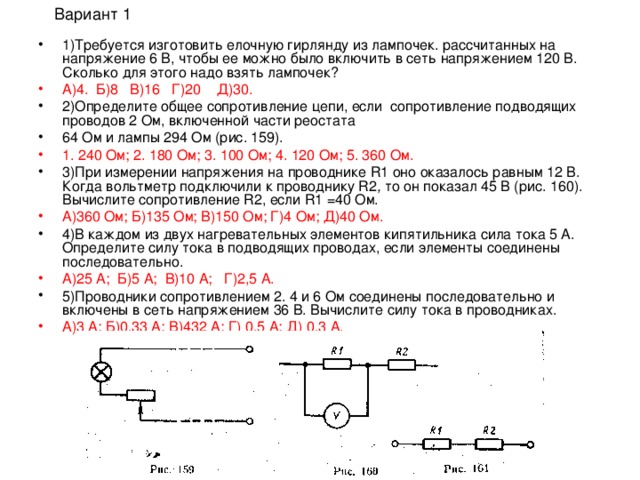
- 1) It is required to make a Christmas tree garland of light bulbs. rated for a voltage of 6 V, so that it can be plugged into a 120-volt line. How many bulbs for this?
- A) 4. B) 8 B) 16 D) 20 D) 30.
- 2) Determine the total resistance of the circuit, if the resistance of the incoming wires is 2 ohms, the included part of the rheostat
- 64 Ohm and a lamp of 294 Ohm (Figure 159).
- 1. 240 Ohm; 2. 180 Ohm; 3. 100 Ohm; 4. 120 Ohm; 5. 360 Ohm.
- 3) When measuring the voltage on the conductor R 1, it turned out to be equal to 12 V. When the voltmeter was connected to the conductor R 2 , then it showed 45 V (Figure 160). Calculate the resistance R 2, if R 1 = 40 Ohm.
- A) 360 Ohm; B) 135 Ohm; B) 150 Ohm; D) 4 Ohm; D) 40 Ohm.
- 4) In each of the two heating elements Boiler current 5 A. Determine the current in the supply wires, if the elements are connected in series.
- A) 25 A; B) 5 A; B) 10 A; D) 2.5 A.
- 5) Conductors of resistance 2. 4 and 6 Ohm are connected in series and included in a 36 V network. Calculate the current in the conductors.
- A) 3 A; B) 0.33 A; B) 432 A; D) 0.5 A; E) 0.3 A.
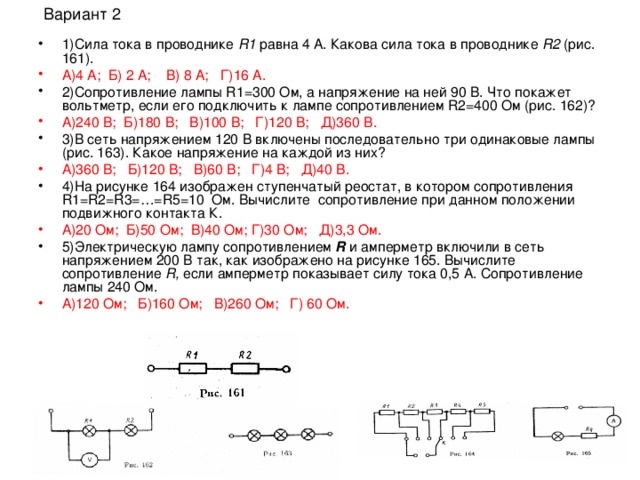
- 1) Current in the conductor R 1 is 4 A. What is the current in the conductor R 2 (Figure 161).
- A) 4 A; B) 2 A; B) 8 A; D) 16 A.
- 2) The resistance of the lamp R 1 = 300 Ohm, and the voltage on it is 90 V. What will the voltmeter show if it is connected to a lamp with resistance R2 = 400 Ohm (Figure 162)?
- A) 240 V; B) 180 V; B) 100 V; D) 120 V; D) 360 V.
- 3) Three identical lamps are connected in series with a voltage of 120 V (Figure 163). What is the voltage on each of them?
- A) 360 V; B) 120 V; B) 60 V; D) 4 V; D) 40 V.
- 4) Figure 164 shows a stepped rheostat in which the resistance R 1 = R 2 = R 3 = ... = R 5 = 10 Ω. Calculate the resistance at a given position of the movable contact K.
- A) 20 Ohm; B) 50 Ohm; B) 40 Ohm; D) 30 Ohm; D) 3,3 Ohm.
- 5) Electric resistance lamp R and the ammeter was plugged into a 200 V network as shown in figure 165. Calculate the resistance R , if the ammeter shows a current strength of 0.5 A. The resistance of the lamp is 240 Ohm.
- A) 120 Ohm; B) 160 Ohm; B) 260 Ohm; D) 60 Ohm.

- In a circuit with a voltage of 12V, a resistor with a resistance of 2 (Ω) is connected. What resistance should be connected to another resistor, so that the current strength is 2A
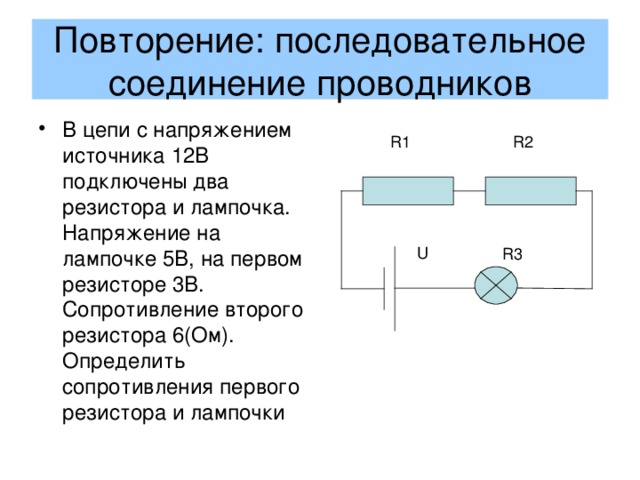
Repeat: Serial connection of conductors
- In the circuit with a voltage of 12V, two resistors and a light bulb are connected. Voltage on the bulb 5V, on the first resistor 3B. Resistance of the second resistor 6 (Ohm). Determine the resistance of the first resistor and light bulb
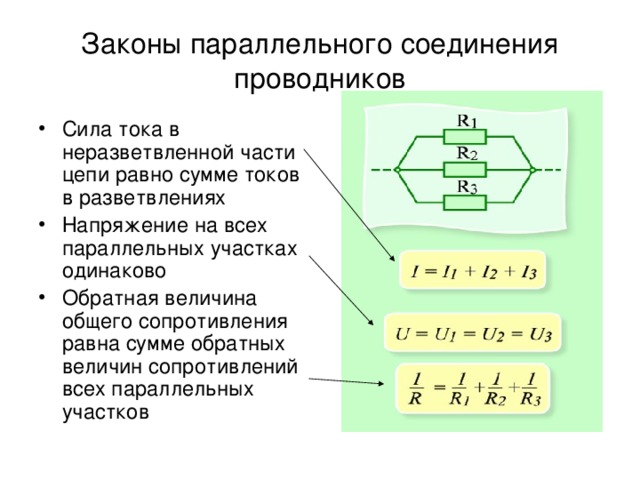
- The current strength in the unbranched portion of the circuit is equal to the sum of the currents in the branches
- The voltage across all parallel sections is the same
- The reciprocal of the total resistance is equal to the sum of the reciprocal resistance values of all parallel sections


Tasks for the parallel connection of consumers


Resistance of the resistors are accordingly equal to 4,6,12 (Ohm). Determine the current in each resistor if the voltage between points A and B is 24V. Determine the current in the unbranched portion of the circuit
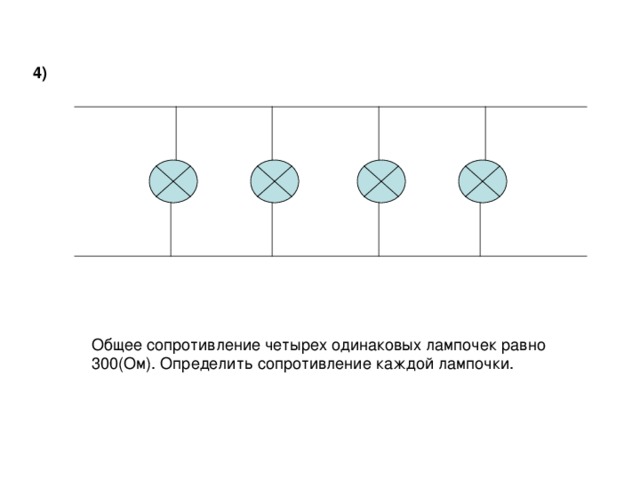
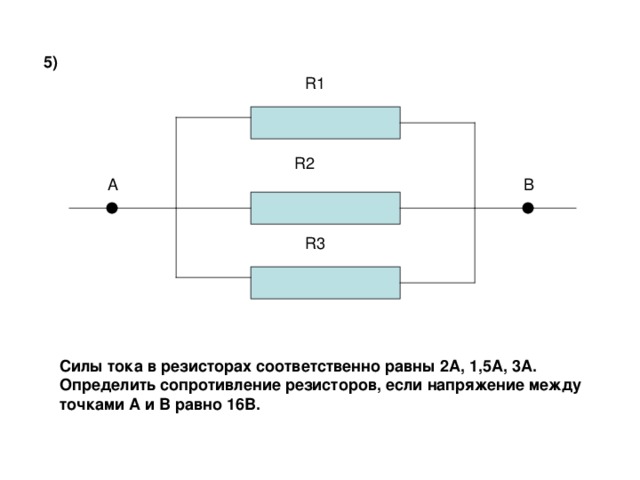
The current in the resistors is 2A, 1.5A, 3A, respectively. Determine the resistance of the resistors if the voltage between points A and B is 16V.
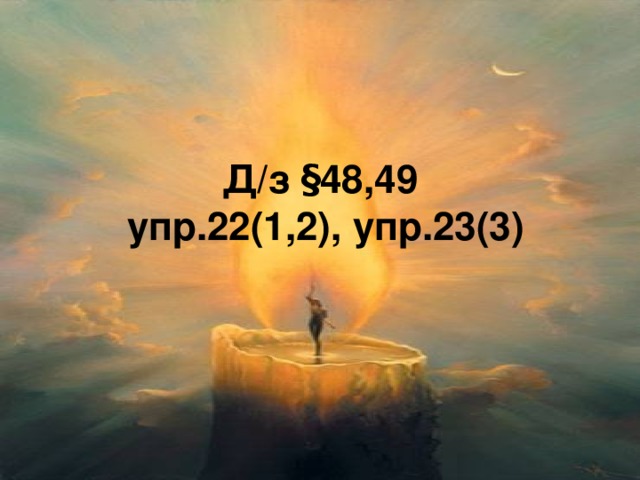
D / s § 48,49 exercise 22 (1.2), exercise 23 (3)
The purpose of the lesson is: 1. To acquaint students with the consecutive and parallel connection of conductors. 2. Regularities existing in a circuit with a serial and parallel connection of conductors. Application 3. To teach to solve problems on a theme: Serial and parallel connection of conductors 4. To consolidate knowledge of students about various connections of conductors and to generate abilities to calculate parameters of the combined circuits
Advantages and disadvantages of the serial connection Advantages: Having elements designed for low voltage (for example, light bulbs), you can connect them in series in the required quantity and connect a source with a high voltage (as arranged Christmas tree garlands). Disadvantage: It is enough for one device (or element) to exit building, as the circuit opens, and all other devices do not work
Advantages and disadvantages of parallel connection Advantages: If one of the branches breaks down the rest continue to work. In this case, each branch can be connected and disconnected separately. Disadvantage: It is possible to switch on devices calculated only for this voltage
The use of a serial connection The main drawback of a serial connection of conductors is that if one of the connection elements fails, the others are turned off. So, for example, if one of the Christmas tree lamps burns out, all others will go out. The indicated deficiency can turn into dignity. Imagine that some circuit must be protected against overload: when the current increases, the circuit should automatically shut off How to do this? (How to do this? (For example, use fuses) When give examples of the use of a serial connection of conductors
The use of parallel connection In parallel, the most diverse consumers can be included in the same electrical circuit electric power Such a connection scheme for current consumers is used, for example, in residential premises. Question to students: How are they connected electrical devices in your apartment?
Can I use two identical lamps, rated at 110 V, in a network with a voltage of 220 V? How? How many identical resistors were connected in series, if each of them has a resistance of 50 Ohm, and their total resistance is 600 Ohm? Two resistors, whose resistance is 5 ohms and 10 ohms, are connected in parallel to the battery. The current strength in which of them is greater? How will the resistance change electrical circuit, if you connect one more resistor to any link of the circuit: a) successively b) in parallel? How to connect four resistors, whose resistance is 0.5 Ohm, 2 Ohm, 3.5 Ohm and 4 Ohm, so that their total resistance is 1 Ohm? Check of knowledge
"Conductors in an electric field" - The dipole. Conductors in electric field. Dielectrics. There is no electric field in other conductors. Because E0 = E1, then E = E0-E1 = 0 There is no electric field inside the conductor. Consider an electric field inside a metallic conductor ...... In an electric field, any dielectric becomes polar.
"Parallel and serial connection" - Laws of a serial connection. Parallel connection of conductors. A1. A2. Task: to allocate in the circuits the section of the serial connection of the conductors. Serial connection. Application of a serial connection. Purpose: to study the various connections of conductors.
"Conductors in an electrostatic field" - The internal field will weaken the outside. Non-polar. +. Yevnesh. The polar. - Metals; liquid solutions and melts of electrolytes; plasma. Yevnutr. Conductors and dielectrics in an electrostatic field. Electrostatic properties of homogeneous metallic conductors. Conductors include: To dielectrics are air, glass, ebonite, mica, porcelain, dry wood.
"HTSC" High-temperature superconductivity (HTSC). The most important discoveries in modern natural science. Opening of the WCS. 1. Investigation of the nature and properties of HTS. 2. The influence of external factors on the properties of HTSC materials. 5. High-current applications. 4. Low-current applications. In accordance with the structure of the program, the main areas of work are:
"Electrical resistance of the conductor" - Insert the missing letters! Scheme 2. Diagram 3. We learn: A) Ammeter - in parallel. Electric current called: E) Ammeter - in series. B) The voltmeter is parallel. Select the pairs. Electrical resistance Designation: Unit of measurement (SI): C) Voltmeter - in series. Calculation of the conductor resistance.
"Connecting conductors" - When the conductors are connected in series: - the current flowing through each conductor is the same: I1 = I2 = I3 - the total voltage in the circuit is equal to the sum of the voltages in the individual sections of the circuit U = U1 + U2 - the total resistance of the circuit is equal to the sum of the resistances of the individual sections of the circuit R = R1 + R2. Connections of conductors.
Total of 6 presentations
Slide text: 1. Laws of connections. 2. Tasks. Parallel and series connection of conductors
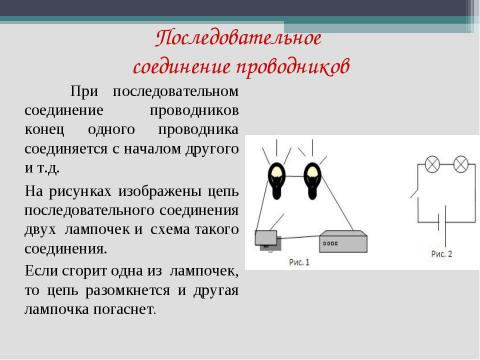
Slide text: Sequential connection of conductors When the conductors are connected in series, the end of one conductor is connected to the beginning of the other, and so on. The diagrams show a circuit of a series connection of two light bulbs and a diagram of such a connection. If one of the light bulbs burns, the circuit will open and another light will go out.
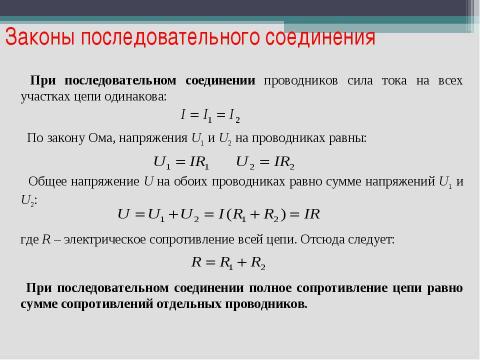
Slide text: When the conductors are connected in series, the current in all sections of the circuit is the same: According to Ohm's law, the voltages U1 and U2 on the conductors are equal: The total voltage U on both conductors is equal to the sum of the voltages U1 and U2: where R is the electrical resistance of the entire circuit. From here it follows: With a series connection, the impedance of the circuit is equal to the sum of the resistances of the individual conductors. Laws of serial connection

Slide text: Parallel connection of conductors When the conductors are connected in parallel, their ends and ends have common points of connection to the current source.
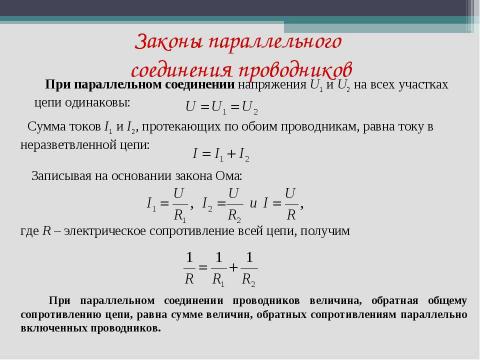
Slide text: The laws of parallel connection of conductors In parallel connection, the voltages U1 and U2 are the same on all sections of the circuit: The sum of currents I1 and I2 flowing through both conductors is equal to the current in an unbranched circuit: Writing on the basis of Ohm's law: where R is the electrical resistance of the entire circuit , we obtain When the conductors are connected in parallel, the reciprocal of the total resistance of the circuit is equal to the sum of the reciprocal of the resistance of the parallel-connected conductors.
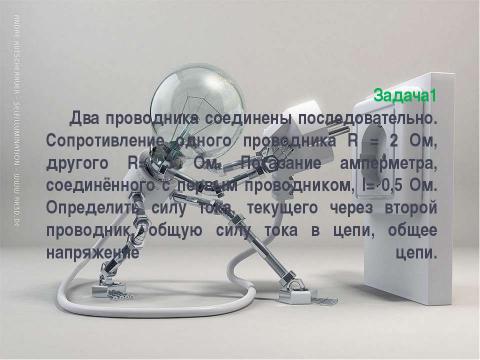
Slide text: Task1 Two conductors are connected in series. Resistance of one conductor R = 2 Ohm, the other R = 3 Ohm. The indication of the ammeter connected to the first conductor, I = 0.5 Ohm. Determine the current flowing through the second conductor, the total current in the circuit, the total circuit voltage.

Slide text: Problem solution Given: R1 = 2 Ω R2 = 3 Ω I1 = 0.5 A Solution: I1 = I2 = Iu; I2 = Iu = 0, 5 A U1 = I1R1; U1 = 0.5 x 2 = 1 (B) U2 = I2R2; U2 = 0.5 x 3 = 1, 5 (B) Uu = U1 + U2; Uu = 1 + 1, 5 = 2, 5 (B) I2, Iu, Uu =? Answer: I2 = Iu = 0, 5 A, Uu = 2, 5 V.

Slide text: Task 2.
Slide # 10
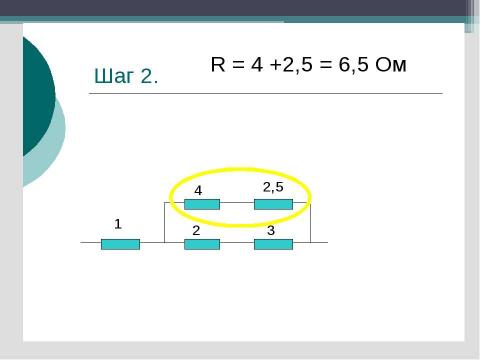
Slide №11

Slide # 12
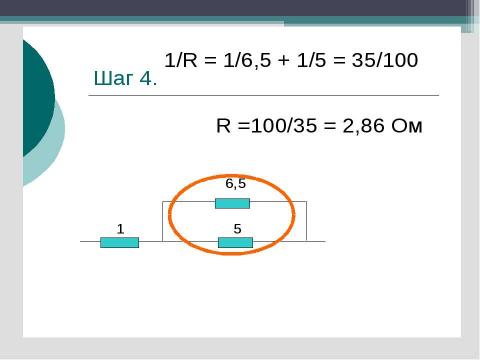
Slide # 13
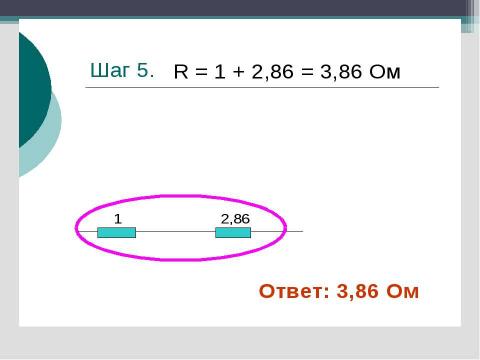
Slide №14

Slide text: Task 3. Doctors Watson and Sherlock Holmes on New Year's Eve invited friends to visit. And, suddenly, as one of the laws of Murphy says: "Everything that must break, necessarily break, and at the most inopportune moment." And, what happened? When the owner of the house began to include a Christmas tree garland for children, one of the bulbs designed for a voltage of 3.5 V burnt out. Children are upset, the owner is in a panic, because there is no spare bulb at hand. We must save the holiday, Holmes decided. And, asking everyone to calm down, Holmes uttered magical words and did one thing. To the universal joy of the children, the garland caught fire. Later, Dr. Watson asked Holmes what had he done? What did Holmes say?
Slide # 15
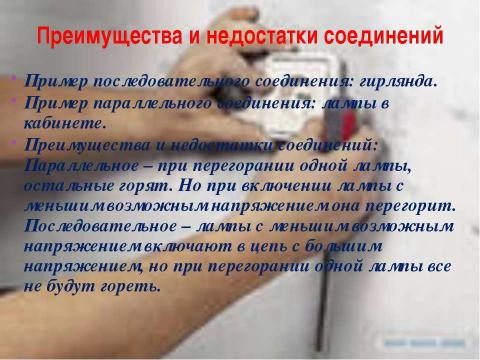
Slide text: Advantages and disadvantages of connections Example of a serial connection: a garland. An example of a parallel connection: lamps in the office. Advantages and disadvantages of the connections: Parallel - when one lamp is burnt out, the others burn. But when you turn on the lamp with less possible voltage, it will burn out. Sequential - lamps with less possible voltage are included in a circuit with a high voltage, but if one lamp is burned out, all will not burn.
Slide # 16

Slide text: Homework: Give examples of consecutive and parallel connections of conductors in your home. Povt. § 48, 49. Exercise. 22 (2), exercise 23 (3.4).













